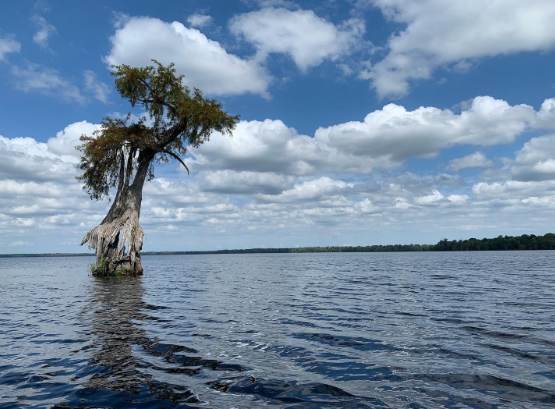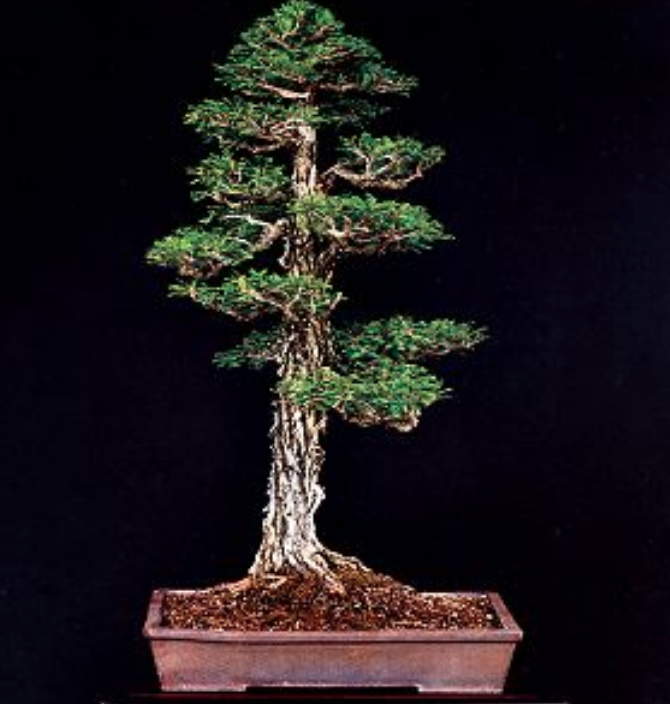This month’s Species Spotlight (by our First Curator’s Assistant, Andy Bello) turns the light on three different species that constitute the genus Taxodium: Bald Cypress (Taxodium distichum), Pond Cypress (Taxodium ascendens) and Montezuma Cypress (Taxodium mucronatum). All three species are located in our collections at The National Bonsai & Penjing Museum.
Old Bald Cypress (Taxodium distichum) at Lake Drummond, VA (Photo by Andy Bello)
Taxodium are extremely flood-tolerant, deciduous conifers in the cypress family Cupressacae. These trees can reach heights of about 100-150 feet and trunk diameters reaching more than 37 feet. A distinctive feature of taxodium is the formation of pneumatophores, also known as “cypress knees.” Some bonsai experts debate whether the knees aid in the uptake of oxygen or if they support the trees in wet soil conditions.
Species history and general facts
Bald cypresses are mainly found along rivers with silt-rich flood deposits throughout the Southeastern United States and even up the Mississippi River into Southern Indiana.
Pond cypresses live within the Southeastern Coastal Plain, from North Carolina to Louisiana, and grow in more stagnant blackwater rivers, ponds and swamps, rather than silt-rich flood deposits.
Montezuma cypresses are found between the lower Rio Grande Valley down to the highlands of Guatemala. This cypress is a riparian tree that grows along streams and rivers. This species tends to be evergreen and not deciduous, given its distribution in a consistently warm climate. Montezuma cypresses on average have the largest trunk size, with some reaching about 37.5 feet in diameter.
Take a look at some of the cypresses we have at the Museum!
Bald Cypress
This bald cypress (Taxodium distichum) #269 is located in the North American Collection. It has been in training since 1972, and the late Vaughn Banting donated the tree in 2000. Banting originally purchased the tree as a nursery plant. This bald cypress, along with one at the Pacific Bonsai Museum, are the first two trained into a configuration Banting championed called “Flat Top Style.” The flat top style with knees protruding from the soil is a very distinctive trait of bald cypresses.
Read more about the history of this bald cypress, Vaughn Banting and the flat top style here.
Montezuma Cypress
This montezuma cypress (Taxodium mucronatum) #274, now located the North American Collection, was donated by Mike Naka in 2004 in honor of his grandfather and bonsai master, the late John Y. Naka.
John Naka purchased this bonsai from a nursery in Los Angeles after traveling from Denver in 1946 and began training the tree in 1948. The bonsai is trained in the formal upright style to invoke the massive height and girth often seen in the species. By keeping the primary branches short and closer to the trunk, Naka provided an even grander image of the species’ height.
Montezuma cypresses are evergreen in their native warm climate, but their seasonal beauty can truly be appreciated when they are allowed to thrive in Northern climates.
Pond Cypress (with bald cypresses)
This group planting of a pond cypress (Taxodium ascendens) and multiple bald cypresses (Taxodium distichum) #250 is located in the North American Collection. Jim Fritchey and Dick Wild donated the planting, comprised of trees collected from the wild Floridian swamps, in 1990 after arranging the original planting in 1988.
As the forest in this planting evolved, a number of trees were removed after some trees couldn’t keep up with the competition for light – a common phenomenon in natural forests. The composition was rearranged to ensure the longevity of the planting.
The photo above is how the planting appears at the Museum today. The large pond cypress on the left with a strong lean provides directionality, while the group of bald cypresses on the right provides depth. The seven-foot stone slab, which weighs about 1,500 pounds, evokes a natural look compared to the typical ceramic container.
Come and visit The National Bonsai & Penjing Museum in all four seasons to experience the beauty of Taxodium in the collection. The lush bright green spring growth and the brilliant red and orange fall foliage is best to appreciate in person. I hope that these trees inspire everyone to work more with native species and create bonsai in a meaningful manner.









